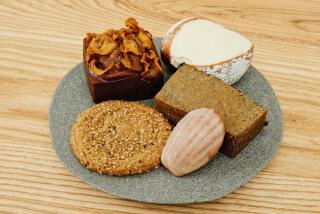Dessert Demonstration Is More Than Just Sweet Talk
When Sumiye Yoshida peered into a glass-and-wood case Saturday, a flood of emotion returned to the 86-year-old. Inside were colorful Japanese delicacies known as mochigashi -- handmade sweets lined up side by side that harbored a lifetime of memories. The sound that the caseâs doors and drawers made when they opened and closed triggered a heavy dose of nostalgia.
âIâve been coming here all my life,â said Yoshida, who grew up down the street from Fugetsu-Do, the Little Tokyo sweet shop that has been a presence in downtown Los Angeles since 1903.
On Saturday, Yoshida took her adult daughter, Dianne Rowell, to the store for a mochi-making demonstration by Brian Kito, who represents the third generation of his family to run Fugetsu-Do.
The event, organized by the Japanese American National Museum, proved to be an opportunity to learn more about the storeâs rich history, as well as to get some pointers on the fine art of making the sweet -- in many ways, a dying art.
More than 50 people attended a lecture at the museum and then returned to the store, which Kito said had been largely unchanged for almost half a century, in part to honor people like Yoshida, whose memories are so intertwined with his familyâs history.
In the shopâs kitchen, 20 people gathered around a rectangular table and leaned close, as Kito demonstrated how to assemble the mochi, made with a rice flour base and often stuffed with bean paste. Mochigashi, the general term used for the desserts, also includes manju, crafted out of cake flour and usually baked or steamed.
It takes 10 years for a person to be considered a professional mochi-maker, Kito said. His employees train at least a year before they can make even the simplest of sweets. Everything is done by hand.
Mari Ostendorf stood quietly to one side of the kitchen, snapping pictures as Kito worked. She said she had attended the demonstration to get a âdeeper appreciation of the arts, the art of confection.â The Santa Monica resident lived in Tokyo for five years -- and since then has been trying to learn more about the history of the dessert.
Saturdayâs session was not, by any stretch, mochi for beginners: Most of the participantsâ questions reflected a deep knowledge of the dessert.
How much sugar do you add to the dough? they asked. (A typical mochi can be 25% sugar, though that percentage changes along with the weather and seasons.) How long do you steam the rice-flour dough before it is considered ready to be shaped? (About 35 minutes, Kito said.)
As he answered questions, his hands moved rapidly, dipping into colorful piles of bean paste and dough, shaping them in quick succession into neat, uniform mounds. He picked up a yellow mound and, with a light touch, carved notches into it. He finished it with a sprig of green gelatin on top. This, he said, was mochi meant to resemble a persimmon.
A few seconds later, Kito grabbed for some dark bean paste, shaped it into a teardrop, coated it with gelatin and then dipped it into poppy seeds. A chestnut, he said.
âEvery store has its own style,â he told participants. âBut the key is that all look the same. The quality of the skill level is judged by consistency.â
Sandy Nishikawa said she had come to celebrate the 100th birthday of a store that was a fixture in her childhood. Nishikawa, 55, said that, when she was a child, a visit to church down the block often had been linked to a trip to the store.
Which kind of mochi did she prefer?
âI like the chofu,â she said, pointing toward the display case, to what closely resembled a fig bar. âI donât know why. I just like it.â
More to Read
Eat your way across L.A.
Get our weekly Tasting Notes newsletter for reviews, news and more.
You may occasionally receive promotional content from the Los Angeles Times.










